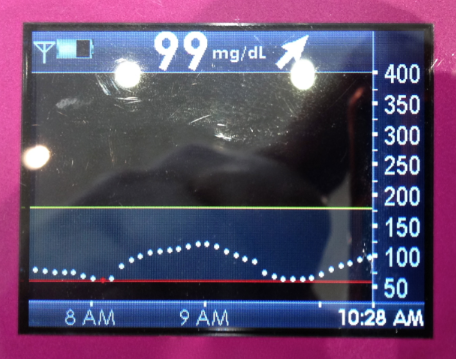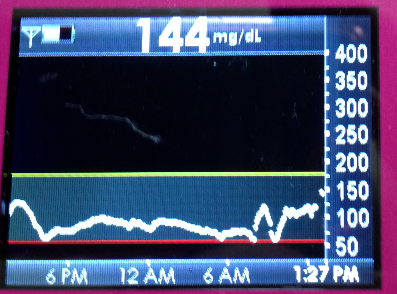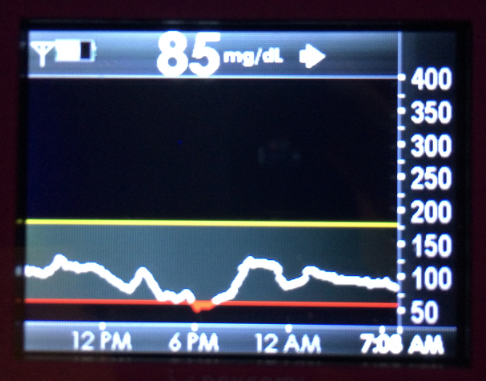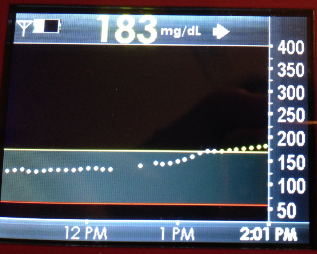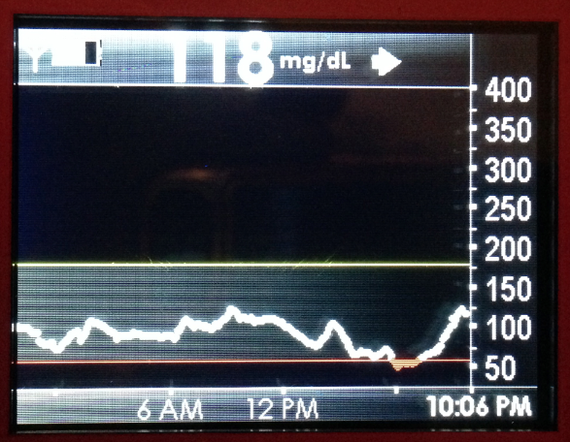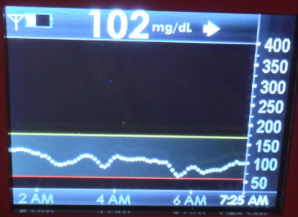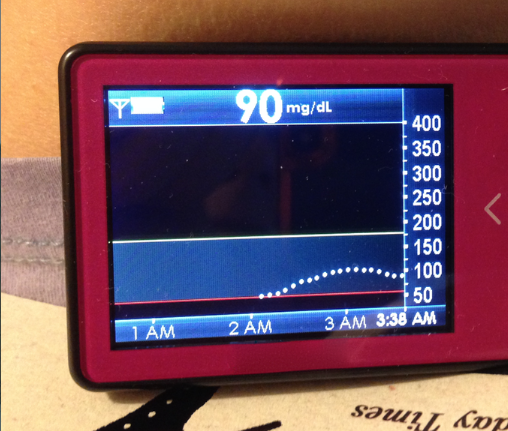Let me say this with no exaggeration. My whole life, all day, all night, every day and each night is about keeping my blood sugar between the red and yellow lines. Whether I'm wearing, or not wearing, my continuous glucose monitor (CGM), screen pictured below.
(The little white dots between the red and yellow lines are my blood sugar levels every five minutes. The 99 mg/dl (5.4 mmol/l) was my blood sugar level the moment I took this photo. The larger white dots are glare from the camera.)
I just explained this "staying between the lines" to my mother, now being able to visibly show her on my monitor what I've long tried to tell her: Type 1 diabetes is a tightrope walk -- all day and all night taking action to anticipate, prevent and recover from my blood sugar going too high and too low.
My life is, and will forever be, staying between the lines.
I got diabetes in February 1972 when I was 18 years old. I'm now 60. I've had diabetes more than four decades, more than two-thirds of my life. I have no memory of what life was like before "staying between the lines."
Type 1 diabetes is the other diabetes. The one you don't hear about on TV commercials -- that's Type 2 diabetes. People with Type 2 diabetes produce insulin but not enough or their body doesn't use it effectively.
While people with Type 2 diabetes also must keep their blood sugar between the lines, it doesn't require as intense effort. Even for those who take insulin, certain hormones they have that Type 1s lack, help to regulate their after meal blood sugars from rising too high and offset severe low blood sugar.
Type 1 diabetes is an autoimmune condition. Your body destroys your pancreas' insulin-producing (beta) cells. You no longer produce insulin, or at most a trace amount.
It's not yet known what causes Type 1 diabetes. Most likely genetics and/or an insulting event like a virus. The only treatment is to replace the insulin your body no longer makes.
Some people wear an insulin pump that delivers a steady drip of insulin 24/7 into the body and larger amounts when you eat. Others, like me, take one or two daily injections of insulin for metabolic functions, plus injections before almost every meal and snack throughout the day. Food, most significantly carbohydrates, raises your blood sugar, insulin lowers it. Total, I take about six injections a day.
When your blood sugar drops below 70 mg/dl (3.8 mmol/l) as it did here at 6 p.m., you are in hypoglycemia. Your brain and muscles stop getting enough glucose (sugar) to function properly. You may tremble, sweat, have trouble catching your breath and your thoughts, feel ravenous, dizzy or tingly. My heart starts pounding in my chest.
If your blood sugar goes below 55 mg/dl (3 mmol/l), you have moderate hypoglycemia. You may slur and appear drunk, experience confusion, become irritable and spasmatic. If your blood sugar falls below 40 mg/dl (2.2 mmol/l), you are in a state of severe hypoglycemia. You may have convulsions or become unconscious. You may need someone to call 911. If a paramedic doesn't show up and give you glucose, you can die.
Hypoglycemia is the personal boogeyman of people with Type 1 diabetes. Trying to stay between the lines doesn't give you much cushion to stay away from hypoglycemia. The American Diabetes Association's Clinical Diabetes reported that a person with Type 1 diabetes aiming for tight control can experience up to 10 episodes of hypoglycemia a week, and severe disabling hypoglycemia once a year.
Further, slightly under 20 percent of individuals with Type 1 diabetes have what's called hypoglycemia unawareness. This means they don't even feel the symptoms of their blood sugar dropping.
On the other hand, if you go above 180 mg/dl (9.9 mmol/l) often over the years, you are prone to diabetes complications. They are the result of too much sugar in your blood which then damages your small and large blood vessels.
High blood sugar can damage almost every organ and system in your body: nervous and gastric systems, eyes, heart, kidneys, feet, hands and whatever I've left out.
180 is the recommendation of the American Diabetes Association. Yet, the American Association of Clinical Endocrinologists has long advised not going above 140 mg/dl (7.7 mmol/l). Drawing the lines yet closer together.
If you met me, you'd have no idea I spend a huge amount of my time managing this serious chronic illness. I look pretty good, I must say. I am generally happy and optimistic. I am active; I can be spotted walking around town when I'm not sitting behind this computer.
You would have no idea that half my mind space is not free, like yours. It's busy doing what it needs to do to stay between the lines: guessing at the amount of carbohydrates in my meals, then checking my blood sugar to see how well I guessed. If not well, taking another injection or eating.
Or I'm preparing and drawing up my shot of insulin, also guessing at the dose, and remembering where on my body I took my last three injections so I don't inject in the same place which can cause scar tissue.
Or I may be switching my syringes, checking my stock of pen needles, putting on a new sensor, ordering more supplies, and feeling my blood sugar plummet when I only meant to lower it a small amount. Then berating myself for over compensating.
There's also time spent wiping residual blood from blood sugar checks off my kitchen cabinets, coffee table and keyboard.
That's why the simplest I can put it is Type 1 diabetes is staying between the red and yellow lines all day and night, every day and every night. Oops, too high. Bring it down, now.
Oops, too low -- below 50 as it was around 6 p.m. -- get it up. Now!
My husband lovingly told me not long after we married that he wanted to know better what it's like to live with Type 1 diabetes. He decided he would start with checking his blood sugar 10 times a day, as I often do, for three days in a row. He lasted one morning and afternoon. "It's too painful," he said, lowering his sad, guilty eyes.
Many people with Type 1 diabetes are annoyed we live in the shadow of Type 2, which gets all the attention. True, we do.
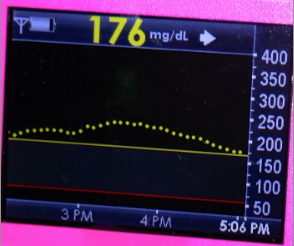
Many people are irritated we get blamed and sneered at for causing our illness -- some people think Type 1 is linked to being overweight and sedentary like Type 2. Not true.
But please, if you're a sneerer, stop. Thin and normal weight people get Type 2 diabetes too, and there's controversy whether weight is a cause or outcome of Type 2 diabetes.
The thing about living with Type 1 diabetes is it's unrelenting.
While I don't wake up throughout the night to check my blood sugar, many parents of children with Type 1 diabetes do check their child's blood sugar during the night.
Yet every night before I go to bed, I have to bring my blood sugar to a level that gives me the greatest possibility of indeed waking up in the morning. A number of people don't, suffering what's called "dead-in-bed syndrome," sudden death in people with Type 1 diabetes attributed to hypoglycemia.
I don't know any other illness where so much work must be done by the patient on a daily basis.
On mornings I don't finish my cereal, an evening I eat an extra piece of bread, the unexpected rain that foils my walk, traveling, eating at people's homes, my insulin weakening, inserting my CGM sensor, walking an extra half hour, deciding to take the bus, deciding not to take the bus, the bus doesn't come so I walk instead, the finger pricks, all day, all night, every day and every night all these things affect my ability to stay between the red and yellow lines.
Last month marked for me 42 years of living with Type 1 diabetes -- 42 years of nonstop work to stay between the lines.
The number "42" seems to have special powers. It's featured in the classic book The Hitchhiker's Guide to the Galaxy as the answer to the question of life, the universe and, well, everything.
I certainly don't know everything. What I do know is even with its demands diabetes has bestowed blessings, and that those with Type 1, and parents of children and teens with Type 1, are working round the clock to delay the potential consequences of having a body that can't regulate normal blood sugars.
Bottom line, Type 1 diabetes is all day, all night, every day and every night staying between the lines.

Riva's latest book, Diabetes Dos & How-Tos, is available in print and Kindle, along with her other books, 50 Diabetes Myths That Can Ruin Your Life and the 50 Diabetes Truths That Can Save It and The ABCs Of Loving Yourself With Diabetes. Riva speaks to patients and health care providers about flourishing with diabetes. Visit her websites DiabetesStories.com and DiabetesbyDesign.com.
